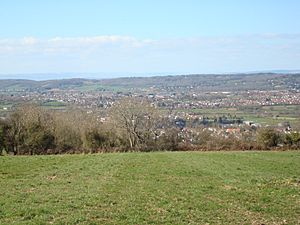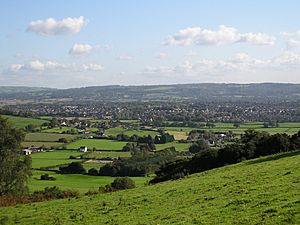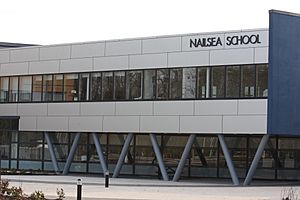Nailsea facts for kids
Quick facts for kids Nailsea |
|
|---|---|
 Nailsea and Backwell viewed from Backwell Hill |
|
| Population | 15,630 (2011) |
| OS grid reference | ST473703 |
| Civil parish |
|
| Unitary authority | |
| Ceremonial county | |
| Region | |
| Country | England |
| Sovereign state | United Kingdom |
| Post town | BRISTOL |
| Postcode district | BS48 |
| Dialling code | 01275 |
| Police | Avon and Somerset |
| Fire | Avon |
| Ambulance | Great Western |
| EU Parliament | South West England |
| UK Parliament |
|
Nailsea is a town in North Somerset, England. It is about 8 kilometres (5 miles) southwest of Bristol. It is also about 11 kilometres (7 miles) northeast of Weston-super-Mare. The village of Backwell is close by, just south of Nailsea across the railway line. In 2021, Nailsea had a population of 15,917 people.
Long ago, Nailsea was a busy place for coal mining and making glass. Today, these industries are gone. Now, most jobs are in service industries, like shops and offices. The area around Nailsea, called the North Somerset Levels, has special places for wildlife. These include the Tickenham, Nailsea and Kenn Moors and Bucklands Pool/Backwell Lake.
Nailsea is easy to reach. It is near the M5 motorway and Bristol Airport. Its train station, Nailsea & Backwell, has trains run by Great Western Railway.
For schooling, older students go to Nailsea School. Younger students attend primary schools like St Francis School, Grove Junior School, Kingshill School, and Golden Valley. There are also old churches, such as the 14th-century Holy Trinity Church.
Contents
History of Nailsea
The name Nailsea might come from an old English phrase meaning "Naegl's island." It was also spelled Naylsey in 1657.
Not much is known about Nailsea before coal mining started. But Romans used the area as a quarry between 40 and 400 AD. They dug out a type of stone called pennant sandstone. The Romans also left a small villa near Jacklands Bridge.
Nailsea's early economy was all about coal mining. People started mining coal here as early as the 1500s. The first record of coal mining in Nailsea is from 1507. By the late 1700s, the town had many coal pits. A social reformer named Hannah More visited Nailsea around this time. She started a Sunday school for the workers.
The Elms Colliery (Middle Engine Pit) is a very old coal mine. It is one of the best examples of an 18th-century mine left in England. It is now protected as a Scheduled Ancient Monument. This means it is an important historical site. Most of the old mines closed by the late 1800s. This happened because better coal was found in South Wales. You can still see parts of the old mines around the town today.
The coal mines brought glass maker John Robert Lucas to Nailsea. In 1788, he opened the Nailsea Glassworks. It became the fourth-largest glass factory in the United Kingdom. They mostly made simple bottle glass. The factory closed in 1873. But "Nailsea" glass is still popular with collectors. This glass was often made by workers at the end of their shifts. The old glassworks site is now a supermarket car park. This makes it easy for future archaeological digs to explore. Other parts of the site have been covered with sand to keep the old remains safe.
Nowhere was a small historical village on the west side of Nailsea. It was taken down in 1967 to build new homes. A small forest called Nowhere Wood is named after it.
To the southwest of town is Nailsea Court. This old building from the 15th century is a Grade I listed building. This means it is a very important historic building.
How Nailsea is Governed
Nailsea used to be part of the Long Ashton Rural District from 1894 to 1974. Now, it is part of the North Somerset local government area. This area is independent, even though it is in the ceremonial county of Somerset. The main offices are in Weston-super-Mare.
Nailsea has four areas for local elections:
- Nailsea Golden Valley
- Nailsea West End
- Nailsea Yeo
- Nailsea Youngwood
Nailsea is also part of the North Somerset area for the national Parliament. This area elects one Member of Parliament (MP) to the House of Commons. The MP is chosen by a system called "first past the post." Since the 2024 election, Sadik Al-Hassan from the Labour Party has been the MP.
Nailsea's Geography and Nature
The Land Yeo river flows east of Nailsea. To the west are the North Somerset Levels. These flat lands have been farmed for many years. Tickenham, Nailsea and Kenn Moors SSSI is a special nature area. It is 129.4 hectares (about 320 acres) big. The soil here is made of clay and peat. It has many small rivers and ditches that are home to amazing plants and insects.
This area has many types of beetles. There are at least 12 types that are rare in the country. Two types are very rare, including Britain's largest water beetle, the great silver water beetle. Nailsea also has several other local nature reserves.
The Bucklands Pool/Backwell Lake local nature reserve is southeast of town. It is near the train station. This lake was built in the 1970s to help control water. Now, it is a home for many wild birds and dragonflies. Bats also hunt for food here. You can see birds like gadwall, shoveler, pochard, tufted duck, grey heron, and mute swans.
Nearby towns and villages include Backwell, Wraxall, Portishead, Clevedon, and Tickenham. Nailsea is about 8 miles (13 km) from the center of Bristol. It is also close to popular places like Weston-super-Mare and Bath. The port of Avonmouth is about 8.5 miles (14 km) away by road.

Climate in Nailsea
Nailsea has a mild climate, like the rest of South West England. It is usually wetter and milder than other parts of the UK. The average yearly temperature is about 10°C (50°F). Temperatures do not change as much as in other places. This is because of the nearby sea. July and August are the warmest months, with average high temperatures of about 21°C (70°F). In winter, the average low temperatures are about 1°C or 2°C (34-36°F).
In summer, high pressure from the Azores Islands affects southwest England. This can sometimes cause clouds to form inland, making the sun shine less. The area gets a bit less sunshine than the regional average of 1,600 hours per year. Most rain in the southwest comes from storms over the Atlantic Ocean. It also comes from warm air rising, which causes showers and thunderstorms. Most rain falls in autumn and winter when Atlantic storms are strongest. In summer, the sun heats the ground, causing rain and thunderstorms. The average rainfall is about 700 mm (28 inches) per year. It usually snows about 8 to 15 days a year. Winds are strongest from November to March and lightest from June to August. The wind usually blows from the southwest.
Nailsea's Economy
Most people in Nailsea work in the service sector. This includes jobs in insurance, banking, defense, shops, and management. You can find jobs in Nailsea in shops, schools, and banks. Bigger companies in Nailsea include General Electric. Also, Bristol Wessex Billing Services Ltd. is here. This company handles bills for Bristol Water and Wessex Water. Other businesses are in industrial areas around town.
Nailsea has several shopping areas. These include Somerset Square, Crown Glass Place, and Colliers Walk. There is also a high street. The town has four big supermarkets: Tesco, Waitrose, Co-op, and Iceland. There are also national banks and estate agents.
The Coates Cider factory in Nailsea opened in 1788. It was bought by Showerings in 1956. The brand later joined with Gaymers. The old factory site is now called 'Coates Estate'. It is home to many different local and national businesses.
Culture and Community Life
Nailsea has several community gathering places. There are youth clubs and two Scouting divisions. These groups help organize the Nailsea Carnival and Mayfair events. Nailsea also has groups for theatre, music, and orchestras. These groups are open to all ages. They meet and perform at places like The Scotch Horn Centre and Nailsea Little Theatre.
Nailsea has outdoor areas for fun. There are playing fields by the Grove Centre and a public park behind the Scotch Horn Centre. There are three children's play parks. The Millennium Park has a skatepark and another children's play area. Nailsea does not have its own cinema. But The Curzon in nearby Clevedon has been open since 1912.
The nearby village of Wraxall has fun places to visit. Noah's Ark Zoo Farm has many animals, including rhinoceros, camels, and monkeys. You can learn about conservation there. Tyntesfield is a large Victorian country house from the 1800s. The National Trust bought it in 2002 and opened it to visitors. The North Somerset Times newspaper publishes a special Nailsea Times edition.
Nailsea has a popular carnival every year. It has been held since the 1960s. All the local schools and scout groups take part. The town also has a very popular beer & cider festival. It happens every July at the Nailsea and Backwell Rugby Football Club. This festival started in 2004. It offers over 160 local drinks each year.
Media
Local TV news for Nailsea comes from BBC West and ITV West Country. TV signals are received from the Mendip and local relay towers.
Local radio stations include BBC Radio Bristol (94.9 FM), Heart West (96.3 FM), Greatest Hits Radio South West (107.2 FM), and Hits Radio Bristol & The South West (106.5 FM).
The local newspapers are the North Somerset Times and the Bristol Post.
Transport
The main road in Nailsea is the B3130. It goes west to Clevedon, where you can get on the M5 motorway. Eastwards, it connects to the A370 (for Bristol) and the A38 (for Bristol Airport). Another road to the A370 in Backwell goes south and west to towns like Weston-super-Mare. Nailsea has free car parks for the first three hours.
Bus services in Nailsea are run by First West of England. The main routes are the X8/9, which go to Bristol every 15 minutes. All bus services in Nailsea are now run by First, except for service 88. This bus goes between Nailsea, Portishead, and Clevedon.
Nailsea & Backwell railway station is just outside Nailsea in Backwell. Great Western Railway manages the station and runs all the trains. The station is only staffed for a few hours on busy mornings. Trains run every day. On weekdays, there are two trains per hour in each direction. These trains go between Taunton and Cardiff Central or Weston-super-Mare and Bristol Parkway. In the mornings and evenings, some trains go directly to and from London Paddington. Platform 1 (westbound) can only be reached by steps. But Platform 2 (eastbound) has steps and a ramp. The station has a car park for 100 cars, which will be made bigger. Over 350,000 journeys start from this station each year.
Bristol Airport is less than 10 kilometres (6 miles) from the town center.
Education
Older students in Nailsea go to Nailsea School. This school became a specialist Technology and Media Arts College. It had a big renovation in 2010 that cost £28.8 million. Nailsea has schools for younger children, including Kings Hill C of E, Golden Valley, Hannah More Infants, St Francis Catholic School, and Grove School. There is also a music school. Ravenswood School helps children with special needs and learning difficulties. There are also playgroups for very young children.
Religious Sites

In the 2021 census, 54% of people in Nailsea said they were Christian. The second largest group, 45%, said they had "no religious preference."
Nailsea Methodist Church started in 1789. Its first building opened three years later. In 1914, a new church opened. A youth club was added in the 1960s. In 1992, the old church was replaced with a bigger, more flexible building. The youth club was also updated and named the Wesley Centre, after Methodism's founder, John Wesley. Nailsea also has a Baptist Church, the Catholic Church of St Francis of Assisi, Southfield Church, the United Reformed Church, and the Community Church.
Sports
Nailsea has four football clubs: AFC Nailsea, Selkirk United, Nailsea United FC, and Nailsea & Tickenham F.C.. These clubs also have junior football teams for kids aged 8 to 16. Nailsea Cricket Club started in the mid-1850s. It has six teams for adults, juniors, and women.
Nailsea also has a ladies hockey club, which started in 1924. The club has two league teams, a youth team, and a veterans team. The Scotch Horn Centre has a gym for aerobic exercise and free weights. It also has squash courts and space for other indoor sports. Nailsea does not have a public swimming pool, even though a group has been trying to build one for a long time. But there is a swimming pool in nearby Backwell. There is also a golf club in Tickenham. Nailsea also has a croquet club with four full-sized lawns.
Nailsea and Backwell Rugby Football Club's top team plays in level 8 of the RFU league system. Their second team plays in Somerset 2 North (level 10).
Notable People from Nailsea
One of Nailsea's most famous people was Adge Cutler. He was a folk singer from Somerset. His band was The Wurzels. He used to work at the Coates cider factory. The Wurzels' album Live at the Royal Oak was recorded at The Royal Oak, a local pub. Adge Cutler is buried in Christ Church graveyard.
Other well-known people who were born, grew up, or live in Nailsea include:
- Mollie Pearce, a TV personality and model. She was a runner-up on The Traitors.
- Mervyn Kitchen was born in Nailsea in 1940. He was a professional cricketer for Somerset County Cricket Club. He scored over 15,000 runs in his career. Later, he became an umpire for 20 Test matches and 28 One Day Internationals. He retired in 2005. Another Somerset cricketer, Stephen Newton, was also born in Nailsea in 1853.
- Charles Sederman, a gymnast who competed in the 1908 Summer Olympics, was born in Nailsea in 1881.
- Professional golfer Chris Wood grew up in Nailsea and still lives there.
- James Heappey, a former MP for Wells, grew up in Nailsea.
See also
 In Spanish: Nailsea para niños
In Spanish: Nailsea para niños







